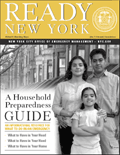-
-
-
-
-
-
-
-
-
-
-
-
-
-
-
-
-
-
Carbon Monoxide
-
-
-
-
-
From the New York City Office of Emergency Management:
Ready New York Household Preparedness Guide
 The cornerstone of the "Ready New York" campaign, this comprehensive household preparedness guide offers tips and information about a wide range of potentially hazardous situations New Yorkers may face.
The cornerstone of the "Ready New York" campaign, this comprehensive household preparedness guide offers tips and information about a wide range of potentially hazardous situations New Yorkers may face.
Read up on how to prepare for weather disasters, fires, earthquakes, carbon monoxide, building collapses, explosions, radiation, hazardous materials or chemical spills, and terrorism. Learn more about evacuation, disaster sheltering, sheltering in place and utilities disruptions. Explore additional information for parents and families, seniors and people with disabilities, pet owners and subway riders.
Once you've familiarized yourself with the guide, print out the emergency reference card and fill in your relevant information. Then, keep it readily available at all times.
Read the guide online by visiting the content (below), download a copy, or call 311 (in NYC) and one will be mailed to you.
Carbon Monoxide
Dangerous levels of carbon monoxide – a colorless and odorless gas – can be produced from improperly vented furnaces, plugged or cracked chimneys, water heaters, fireplaces, stoves and tail pipes.
One of the most dangerous sources of carbon monoxide is car exhaust. Additionally, any appliance that burns fuel may emit carbon monoxide. Gas kitchen ranges and kerosene space heaters may emit carbon monoxide if they are not properly ventilated.
Hundreds of people die from carbon monoxide poisoning every year, and thousands of others suffer dizziness, severe headache and nausea.
Symptoms of Carbon Monoxide Poisoning:
People with carbon monoxide poisoning often report feeling sick and having feelings of malaise which continue to worsen. The most common symptom of carbon monoxide poisoning is HEADACHE. However, symptoms may also include dizziness, chest pain, nausea and vomiting. In severe cases, people can become increasingly irritable, agitated and confused, eventually becoming lethargic and lapsing into unconsciousness.
IF YOU SUSPECT CARBON MONOXIDE POISONING:
- Leave your home.
- Call 911.
- Get any victims to fresh air immediately.
- Open windows.
- Call your local utility.
Tips for Preventing Carbon Monoxide Poisoning:
- Make sure you have a working carbon monoxide detector. Check and change batteries often.
- Make sure your heating system is kept clean and properly vented and that any worn or defective parts are replaced.
- Have your chimney and flue cleaned regularly to remove soot deposits, leaves, etc.
- Don't use kerosene or propane auxiliary heaters indoors, as this can reduce oxygen levels and cause carbon monoxide buildup. These heaters are illegal in New York City and in many Westchester communities.
- Do not use any gas-powered appliance, such as a generator, indoors.
- Do not use charcoal to cook indoors.
- Don't use your gas range or oven to heat rooms, as this can reduce oxygen levels and cause carbon monoxide buildup.
- Automobile exhaust contains carbon monoxide. Open your garage door before starting your car and do not leave the motor running in an enclosed area.
- Check your vehicle's exhaust pipe before starting it to ensure it is clear of snow or other materials. If the pipe is clogged, the exhaust could back up into your car.
